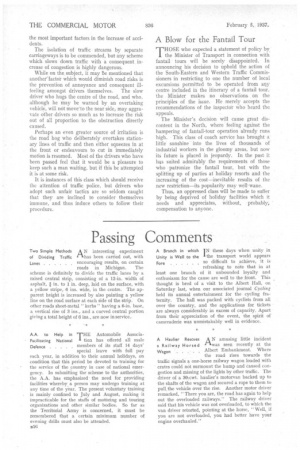Factors in Safe Driving
Page 29

Page 30

If you've noticed an error in this article please click here to report it so we can fix it.
I N an article dealing with contributory causes of road accidents published by Municipal Engineering, that journal draws attention to a system which it has recommended in the case of dangerous pedestrian crossings. This is to divide the carriageway into narrow traffic lines by means of island refuges.
Such islands have existed on certain roads for many years, but although they may have proved themselves satisfactory from the pedestrian point Of* view, they frequently greatly increased the danger of accident amongst the traffic, par ticularly when they are not efficiently lighted.
The main difficulty is that an island is often not seen until a vehicle is almost on top of it; especially is this the case when a small vehicle is following a larger one and, perhaps, endeavouring to overtake it, in which case the former draws out and either has to brake suddenly or to cut in on the latter to avoid hitting the island.
If there is to be any segregation into traffic lanes, then a continuous division, such as that on the Great West Road; -is greatly preferable, for it reduces -that element of surprise which is one of the most important factors in the increase of accidents.
The isolation of traffic streams by separate carriageways is to be commended, but any scheme which slows down traffic with a consequent increase of congestion is highly dangerous.
While on the subject, it may 15e mentioned that another "factor which would diminish road risks is the prevention of annoyance and consequent ill feeling amongst drivers themselves. The slow driver who hugs the centre of the road, and who, although he may be warned by an overtaking vehicle, will not move' to the near side, may aggravate other drivers so much as to increase the risk out of all proportion to the obstruction directly caused.
Perhaps an even greater source of irritation is the road hog who deliberately overtakes stationary lines of traffic and then either squeezes in at the front or endeavours to cut in immediately motion is resumed. Most of the drivers who have been passed feel that it would be a pleasure to keep such a man waiting, but if this be attempted it is at some risk.
It is instances of this class which should receive the attention of traffic police, but drivers who adopt such unfair tactics are so seldom caught that they are inclined to consider themselves immune, and thus induce others to follow their procedure.
A Blow for the Fantail Tour
THOSE who expected a statement of policy by 1 the Minister of Transport in connection with fantail tours will be sorely disappointed. In announcing his decision to uphold the action of the South-Eastern and Western Traffic Commissioners in restricting to one the number of local excursions permitted to be operated from any centre included in the itinerary of a fantail tour, the Minister makes no observations on the principles of the issue. He merely accepts the recommendations of the inspector who heard the appeals.
The Minister's decision will cause great discontent in the North, where feeling against the hampering of fantail-tour operation already runs high. This class of coach service has brought a little sunshine into the lives of thousands of industrial workers in the gloomy areas, but now its future is placed in jeopardy. In the past it has suited admirably the requirements of those who • patronize the fantail tour, but with the splitting up of parties at holiday resorts and the increasing of the cost—inevitable results of the new restriction--its popularity may well wane.
Thus, an oppressed class will be made to suffer by being deprived of holiday facilities which it needs and appreciates, without, probably, compensation to anyone.




























































































